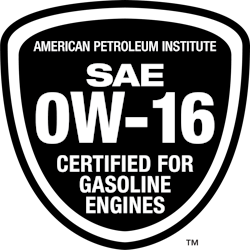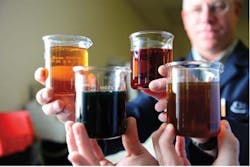When you change oil in your gasoline-powered pickup truck or vehicle, do you take a second to look at the API (American Petroleum Institute) symbol on the container to make sure you’re using the correct oil for your engine?
If not, then change your ways, because as engine oils become ever more technically advanced, using the wrong product can get you into trouble, especially with some new SAE 0W-16 formulations now available and recommended for use in certain models from Japanese auto makers.
You’re probably familiar with the API “Donut” and “Starburst” certification marks, but be on the lookout for a new mark, the “Shield.” In June, API announced approval of three improved performance standards (ILSAC GF-6A, ILSAC GF-6B, and API SP), and oils meeting the new standards for spark-ignited gasoline engines can be licensed under API’s auspices beginning May 1, 2020.
A bit of background might be helpful. ILSAC (International Lubricant Specification Advisory Committee) includes members of the American Automobile Manufacturers Association and the Japan Automobile Manufacturers Association. ILSAC’s mission is to define the need, parameters, licensing, and administration of lubricant specifications.
API, formed in 1919, is a national trade association representing all facets of the natural gas and oil industry and serves as a standards-setting organization. API’s Engine Oil Licensing and Certification System (EOLCS) is a voluntary licensing and certification program that authorizes engine-oil marketers, who have products that meet specified requirements, to use the API Engine Oil Quality Marks (Donut, Starburst, and now, Shield).
The EOLCS is a cooperative effort among the oil and additive industries, ILSAC members, and the Truck and Engine Manufacturers Association. Performance requirements and test methods adopted by the EOLCS are established by vehicle and engine manufacturers, in conjunction with technical societies and trade associations, such as ASTM International (formerly American Society for Testing and Materials), SAE (Society of Automotive Engineers), and ACC (American Chemistry Council).
Standards are developed under API’s American National Standards Institute (ANSI) accredited process, says API’s Kevin Ferrick, director, API Product Programs, ensuring, that the standards are recognized not only for their technical rigor, but also for their development through a consensus-based process.
“API developed these new performance standards in response to requests from automakers to introduce more robust engine oils that would be capable of meeting the needs of current and future gasoline engines,” says Ferrick. “The standards were developed over seven years, and in that time, a number of new tests were developed, evaluated, and measured for precision. Now, oil marketers are working to develop oils that meet these standards to ensure current and future engines perform as designed.”
Among the new tests are a chain-wear evaluation, to assess an oil’s ability to protect the timing chain, and a low-speed-pre-ignition test for oils used in smaller, turbocharged, gasoline engines with direct injection.
Licensed oils meeting the ILSAC GF-6A standard will be allowed to display the API Starburst, and can be used in applications recommending oils meeting GF-5 or earlier gasoline-engine-oil standards. Oils meeting ILSAC GF-6B will be allowed to display the new API Shield and can be used only in applications recommending SAE 0W-16 oils meeting the API SN standard. (GF-6B formulations can only be SAE 0W16 oils, but other low-viscosity oils could be added to the standard in the future.) The new API SP standard includes all of the ILSAC requirements, says Ferrick, and also provides performance requirements for oils that do not fall under ILSAC-member recommendations (primarily for fuel economy).
When marketers want to license a new oil, they test the product according to EOLCS standards and procedures in an in-house or independent laboratory, and once passing results are attained, test results are submitted to API for evaluation, along with supporting data. API then continues to monitor licensed products in the market to ensure that the oil being sold is actually the product that was licensed.
Bottom line: “The OEMs state what oil to use in their engines, and it’s up to the consumer to pay attention to the recommendation,” says Ferrick. “There was need for a plan to make clear the distinction between 0W-20 Starburst oil and 0W-16 Shield oil. OEMs want to make sure that if 0W-20 is specified, then 0W-16 is not used—and vice versa.



